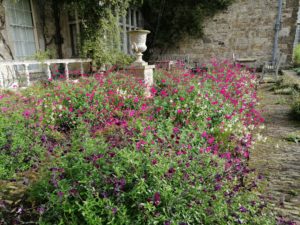I have been in horticulture for over 40 years and have been lucky enough to have worked at some stunning Houses and gardens through my career. This has given me an in depth understanding of Gardens and plants, but it never ceases to amaze me that every day you are learning something new. This is the joy of gardening, continually striving to learn more and do things better.
It may seem daunting to start with but the simple pleasures of sowing a seed or taking a cutting and watching it grow into a full-size plant never goes away.
For the past two years I have been working at Parham House and Garden in West Sussex as Head Gardener. The garden has always had a bindweed issue and during lockdown, when staff and volunteers were largely absent, the size of the problem was fully realised. It was decided that a major programme of renewal was needed involving emptying beds completely to enable the control of the bindweed more effectively. Once some of the beds were clean, we could start thinking about the new plantings in these beds. Many of the borders at Parham have a colour theme which we wanted to maintain, but I was also very conscious of our ever-changing climate and coming off the back of a very hot summer we are looking at plants that can tolerate these extreme conditions.
Trying to maintain the feel of an historic garden with exuberant borders while taking in to account these changing conditions is a challenge but certainly not unsurmountable. I have long had an interest in Salvias and in these times, they are becoming more and more valuable.
There is a huge variety of species and cultivars, from 4-metre-tall perennials to ground hugging shrubs to tender annuals and everything in between. A lot of these plants are tolerant of a wide range of conditions and have scented foliage and a long flowering season. Undoubtedly my favourites are the smaller shrubby Salvias from Mexico. Of these Salvia microphylla and its varieties are the hardiest as they come from higher elevations in the mountains. Salvia gregii comes from lower elevations and is less hardy and these two hybridise to form Salvia x jamensis. All of these three are crossed with other shrubby Salvias to get new colour breaks and two colours on one flower such as Salvia ‘Hot Lips’.

Three of my favourites are in the picture and are planted in the beds in front of the house at Parham. Salvia ‘Nachtvlinder’ with its rich velvet flowers is a low spreading shrub, whilst Salvia microphylla ‘ Pink Blush’ has a pale pink flower and is a little taller. Salvia ‘Dayglow in the background has richer magenta pink flowers on an upright shrub to 1 metre tall and in my opinion is the best of them all. All of these have an incredibly long flowering season form June until October, in fact the picture was taken in the third week of October and very drought tolerant once established. Their flowering does seem to slow down in extreme heat but perks up again once a little cooler. They are also robust hardy plants although with our milder winters there are few of these shrubby Salvias that do not survive our winters now so long as they are given reasonable drainage and do not get waterlogged. Surely there is a place in most gardens for these wonderful plants.
Parham House and Gardens open again on Sunday 9th April 2023 to find out more visit their website
http://www.parhaminsussex.co.uk

